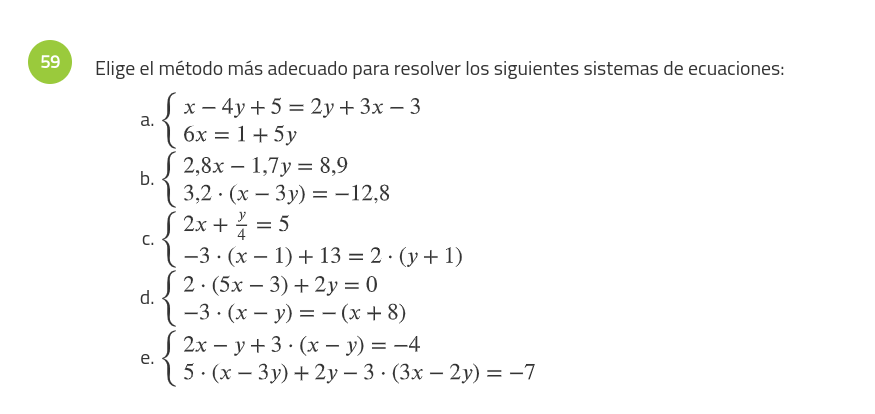Elige el método más adecuado para resolver los siguientes sistemas de ecuaciones: a. \begin{cases} x - 4y + 5 = 2y + 3x - 3 \\ 6x = 1 + 5y \end{cases} b. \begin{cases} 2.8x - 1.7... Elige el método más adecuado para resolver los siguientes sistemas de ecuaciones: a. \begin{cases} x - 4y + 5 = 2y + 3x - 3 \\ 6x = 1 + 5y \end{cases} b. \begin{cases} 2.8x - 1.7y = 8.9 \\ 3.2(x - 3y) = -12.8 \end{cases} c. \begin{cases} 2x + \frac{y}{4} = 5 \\ -3(x - 1) + 13 = 2(y + 1) \end{cases} d. \begin{cases} 2(5x - 3) + 2y = 0 \\ -3(x - y) = -(x + 8) \end{cases} e. \begin{cases} 2x - y + 3(x - y) = -4 \\ 5(x - 3y) + 2y - 3(3x - 2y) = -7 \end{cases}

Understand the Problem
La pregunta pide identificar el método más adecuado para resolver cada uno de los sistemas de ecuaciones lineales presentados. Esto implica analizar la estructura de cada sistema para determinar si es más conveniente usar sustitución, igualación, reducción (eliminación), o algún otro método para encontrar los valores de las variables que satisfacen ambas ecuaciones en cada sistema.
Answer
a. Sustitución b. Sustitución c. Sustitución d. Sustitución e. Reducción (Eliminación)
Answer for screen readers
a. Sustitución b. Sustitución c. Sustitución d. Sustitución e. Reducción (Eliminación)
Steps to Solve
a. Simplifying the equations
First, simplify both equations to put them in a standard form.
Equation 1: $x - 4y + 5 = 2y + 3x - 3$ simplifies to $-2x - 6y = -8$, or $x + 3y = 4$.
Equation 2: $6x = 1 + 5y$ can be rewritten as $6x - 5y = 1$.
Choosing the method
Since we can easily isolate $x$ in the first equation ($x = 4 - 3y$), substitution is a good choice.
b. Simplifying the equations
Simplify the second equation: $3.2(x - 3y) = -12.8$ becomes $3.2x - 9.6y = -12.8$.
Choosing the method
Notice that we could divide the second equation by $3.2$ to get $x-3y=-4$ Then isolating $x$ gives is $x = 3y - 4$. Given the decimals in the first equation, isolating $x$ or $y$ and then using substitution seems like the easiest choice. Substitution would be ideal here.
c. Simplifying the equations
Simplify both equations.
Equation 1: $2x + \frac{y}{4} = 5$
Equation 2: $-3(x - 1) + 13 = 2(y + 1)$ becomes $-3x + 3 + 13 = 2y + 2$, simplifying to $-3x - 2y = -14$.
Choosing the method
Clearing the fraction in the first equation results in $8x + y = 20$. Isolating $y$ in the first equation is simple: $y = 20 - 8x$. So substitution would work Alternatively, multiplying the first equation by 8 and the bottom by 1 may make elimination easier.
d. Simplifying the equations
Simplify both equations.
Equation 1: $2(5x - 3) + 2y = 0$ becomes $10x - 6 + 2y = 0$, or $10x + 2y = 6$, which simplifies to $5x + y = 3$.
Equation 2: $-3(x - y) = -(x + 8)$ becomes $-3x + 3y = -x - 8$, simplifying to $-2x + 3y = -8$.
Choosing the method
From the first equation, we get $y = 3 - 5x$. Then we can plug this into the second equation. Alternatively, we could multiply the first equation by $-3$ and use elimination. Substitution seems like our best bet.
e. Simplifying the equations
Simplify both equations.
Equation 1: $2x - y + 3(x - y) = -4$ becomes $2x - y + 3x - 3y = -4$, simplifying to $5x - 4y = -4$.
Equation 2: $5(x - 3y) + 2y - 3(3x - 2y) = -7$ becomes $5x - 15y + 2y - 9x + 6y = -7$, simplifying to $-4x - 7y = -7$.
Choosing the method
We have $5x - 4y = -4$ and $-4x - 7y = -7$.
We do not have any easy options for substitution here. Therefore, we should use elimination.
a. Sustitución b. Sustitución c. Sustitución d. Sustitución e. Reducción (Eliminación)
More Information
The best method for solving systems of equations depends on the specific structure of the equations. Substitution involves solving one equation for one variable and substituting that expression into the other equation. Reduction (elimination) involves manipulating the equations so that when they are added or subtracted, one of the variables is eliminated.
Tips
Null
AI-generated content may contain errors. Please verify critical information